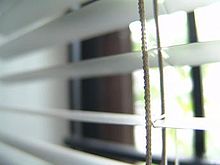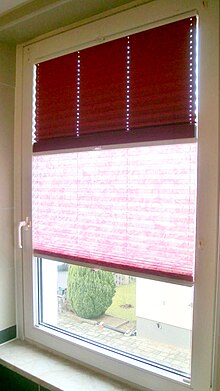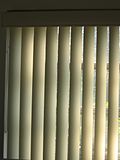Window blind: Difference between revisions
m →See also: no |
|||
| Line 75: | Line 75: | ||
==See also== |
==See also== |
||
{{Commons}} |
{{Commons}} |
||
*[[Window shutter]] |
* [[Window shutter]] |
||
* [[Curtain]] |
* [[Curtain]] |
||
[http://www.bruceblinds.co.uk Blinds] |
|||
*[http://www.soeasyblinds.co.uk/Product.aspx?pid=5 Roller Blinds] |
|||
* [[Domotics]] |
* [[Domotics]] |
||
*[[Mini blind]] |
* [[Mini blind]] |
||
* [[Sudare]] |
* [[Sudare]] |
||
Revision as of 20:08, 18 April 2009
This article needs additional citations for verification. (November 2007) |
- For other uses see Blinds (disambiguation)
- For the desktop theming software, see WindowBlinds.

A window blind is a specific type of window covering which is made with slats of fabric, wood or metal that adjust by rotating from an open position to to a closed position by allowing slats to overlap. Metal window blinds are often used outside of the house or business to protect against theft, temperature, vision, bad weather and fire (in fire-prone areas). Often these blinds are machine-operated, rather than hand operated.
The horizontal version uses a thin woven "ladder" system to suspend the slats and enable slats to be closed via a rotating drum to which each upper end of the woven ladder is wrapped and attached. A lift cord allows blind to be pulled up and stack tightly to top of window when desired.
The vertical version uses a generally wider slat and has the added feature of being able to pull a cord to stack the slats together either to one side or to separate in the center and stack on each end. This vertical blind allows rotation of slats by a rotating shaft in the upper head rail housing which runs throgh independent geared carriers that will convert twisting of tilt rail to a rotation of each individual slat in sync.
The term Window blinds is also sometimes used, somewhat inaccurately, to describe window coverings generically - in this context window blinds include most every type of window covering ie. shutters, roller shades, roman shades and of course, vertical and horizontal blinds.
In Britain awnings are also considered blinds. A blind limits observation and thus “blinds” the observer to the view. The main types are slat blinds which can be opened in two ways and solid blinds.
Solid blinds can only be raised or lowered and are often called shades. There are types of blinds, such as Holland blinds and woven-wood blinds, where there are small spaces between the slats. In others such as pleated shades there are no spaces because the slats are sewn inside fabric.
Window blinds reduce the heat from sunlight. Ancient Egyptian pharaohs had blinds made of reeds. The most inexpensive blinds in the 1800’s were home-made roller shades, made of cloth.
Window blinds can be manually drawn using a cord, or automated through motorization. Controls for motorized blinds can be from a wall switch or keypad, remote control, or a personal computer, eliminating the need for cords and allowing control of otherwise inaccessible windows.
Varieties
Persian, or Slat

The most common window blinds are slat blinds, which consist of many horizontal slats, usually of metal or vinyl, connected with string in a way that they can be rotated to allow light to pass between the slats, rotated up to about 170 degrees to hide the light, or pulled up so that the entire window is clear. Vertical blinds consist of slats of stiffened fabric, plastic, or metal hanging by one end from a track; like the horizontal versions, the slats can be rotated 90 degrees to allow light to pass through or to fold up on one side of a door or window. Vertical blinds are very good at controlling how much natural or exterior light comes into a room, due to the ability of the slats to close tightly.
Venetian
A Venetian blind has horizontal slats, one above another. They are suspended by strips of cloth called tapes, or by cords, by which all slats in unison can be rotated through nearly 180 degrees. The slats can be rotated such that they overlap with one side facing inward and then in the opposite direction such that they overlap with the other side facing inward. Between those extremes, various degrees of separation may be effected between the slats by varying the rotation. There are also lift cords passing through slots in each slat. When these cords are pulled, the bottom of the blind moves upward causing the lowest slats to press the underside of the next highest slat as the blind is raised. A modern variation of the lift cords combines them with the rotational cords in slots on the two edges of each slat. This avoids the slots otherwise required to allow a slat to rotate despite a lift cord passing through it, thus decreasing the amount of light passing through a closed blind.
Venetian blinds are basic slatted blinds made of metal or plastic; wooden slats are sometimes used but these are usually referred to as wood blinds or bamboo blinds. Venetian blinds were patented by Edward Beran in London on 11 December 1769[1], but in reality Venetian blinds were invented by the Japanese long before then. Slat width can be between 16-120 mm, with 50 mm being a common width.

Vertical
Unlike horizontal blinds, vertical blinds are less likely to be damaged in strong winds, to hold dirt and be less likely to break down. Generally they require less muscle strength, and are faster to operate.
Stationary vertical blinds are hung in the doorways of some homes and businesses which generally leave the door open. Movement of the blind may signal a change in air flow, or someone entering the doorway. More commonly however, these vertical blinds are made of thick plastic. In the clod rooms of food businesses, this slows the leak leakage into the cold room. In warmer climates, vertical blinds discourage flies and some other insects from entering the building.
Others
Other variety of window blinds include mini blinds (venetian blinds with very narrow slats 1"(usually 25 mm wide), micro blinds 1/2"(usually 12 mm wide), louvers, jalousies, brise soleil, Holland blinds, pleated blinds, honeycomb blinds (similar to pleated shades except that there are two or more layers joined at the pleats to form compartments that trap air, providing insulation), Roman shades, and roller shades.
Materials
A window blind is a means of screening a window, achieving similar results to those obtained by fitting curtains. Blinds are typically the same width and height as the window itself or slightly wider and taller - depending on whether they are fixed inside or outside the window's reveal (i.e. the wall recess within which the window itself is fixed).
Window blinds have varying thermal effects: they can block unwanted heat of the summer sun and they can keep in heat in cold weather. But in both of these applications, they also reduce light to varying degrees, depending on the design. Many kinds of blinds attempt varying balances of privacy and shade. Blinds can be made of a number of different materials and manufactured in a number of different ways. This usually determines the name by which the blind is commonly known.
Fabric
Blinds made of fabric can either roll up around a metal batten (roller blinds), fold up thanks to a thin cord and small horizontal slats (Roman blind), folding blinds with no horizontal slats create a less structured look (Austrian blinds).
Wood
Wooden blinds are generally known as Venetian blinds. A number of horizontal wooden slats are joined together by corded pulleys which can either gather all the slats at the top of the window to reveal the view or simply angle the slats while allowing some light to travel through the blind yet retaining some level of privacy. Wooden blinds come in a number of finishes (determined by the type of wood used, which ranges from painted to most types of solid oak varieties) and sizes (determined by the width of each slat which is usually available in one of three widths - 25 mm, 35 mm or 50 mm). Wooden Venetian blinds are also available as vertical blinds. These are usually made up of wider slats and operate in virtually the same way as their horizontal counterparts (i.e. instead of being drawn upwards to reveal the window, the draw to one side gathering in a vertical bunch).
Pinoleum blinds are made up of small wooden twigs laid horizontally which are joined together by vertical threading. The resulting weave is, as a result, only flexible vertically and can be drawn upwards once manufactured as a roller blind or in a similar fashion to a Venetian blind. Conservatory blinds are often made with Pinoleum.[citation needed] Drawings in ancient Egyptian tombs of reed blinds have been reported[who?] and a common window blind during the 1800’s is said to have been the home-made roller shade.
Other materials
Venetial blinds, both horizontal and vertical, are available in a number of man-made materials (either resembling wood or metal or simply plastic). These are better suited to areas where moisture or direct contact with water is likely to cause a problem, such as bathrooms and kitchens. These blinds are often available with micro slats (as small as 16 mm or less). The result of smaller slats is that more have to be used to obscure the window completely. Conservatory blinds (i.e. ceiling fixed via a number of horizontal pulleys) are often made of man-made materials.
Automobile blinds
Some vehicles include or are retrofitted with sun blinds for rear and rear side windows. See also car glass. These blinds are used to protect the vehicle and the passengers from direct sunlight. The rays of the sun can damage the interior of most vehicles over time.[citation needed] Blinds on the side windows can be important for protecting adults and especially infants. Car window blinds are usually mounted with brackets and are easy to install or remove.[citation needed]
Car shades are another common way to protect the vehicle. The shades for the rear and front windows are designed to be unfolded and sit against the window. They can be made of plastic or cardboard. The shades that go on the side windows of a vehicle are usually attached using suction cups or using static cling.
Solid fabric and slat car blinds have given way to cheaper and more flexible, folding wire-framed "dark-stocking" synthetic blinds. These are used where the car owner has not dark-tinted the glass of the car windows enough. or during the day, wishing to have more privacy.
Gallery
- Some Window Blinds
-
Close-up of a track blind
-
Track Blind
-
Close-up of a pleated shade
-
Blind with horizonal slats
-
Detail of turning rod (blind stick) attachment on miniblind
-
A roller blind on a door





